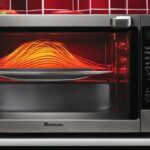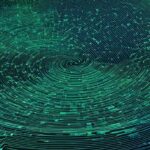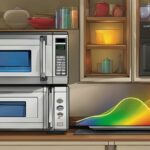Last Updated on 3 years by Francis

First and foremost, infrared rays or radiation (IR) is a type of radiant energy that cannot be seen by the human eye but can be felt as heat. Nearly all living and nonliving things in the universe emit some form of infrared radiation. However, the two primary sources of infrared rays are fire and the sun.
Infrared can also be described as a continuum of electromagnetic frequencies that occur when atoms consume and then release energy. This makes infrared a form of electromagnetic radiation. Other types of electromagnetic radiation found in the universe include radio waves, microwaves, visible light, ultraviolet (UV) radiation, X-rays, and gamma rays. All these forms of electromagnetic radiation come together to form the electromagnetic spectrum as we know it.
Discovery of Infrared

An Astronomer named Sir William Herschel is believed to have discovered infrared radiation in the year 1800. Sir Frederick William Herschel was born in Germany in the year 1738 but later moved to England in 1757. He was initially a well-known musician in a small town called Bath. He also worked as a composer and director in the local orchestra before diving into the world of astronomy with his sister Caroline. Sir Frederick William Herschel was one of the most prolific telescope makers of is era. He and his sister studied the skies for many years, and this led them to create a comprehensive model of our Galaxy which they called “The Construction of the Heavens.” Among his most notable achievement, Sir Frederick William Herschel is probably remembered as the person who discovered the planet Uranus.

In 1800, Herschel conducted an experiment to identify the color of the light that carried the Sun’s heat. To his utter amazement, his thermometers detected heat at a point where the sun’s light had already separated into its individual colors. The heat could still be detected beyond the visible end of the spectrum. At first, he thought of measuring how much heat passed through each of the colors that made up the spectrum. He assumed that the individual colors had different levels of heat, so he came up with an experiment to prove this.

Herschel direct sun ray through a prism to form a ‘rainbow’ spectrum and measured the temperature of each color in the spectrum using different thermometers. He also had two thermometers positioned on the far ends of the spectrum to act as control samples. He blackened all the thermometers to improve absorption of heat. While measuring the temperature of each color, Herschel would confirm his readings by comparing them to the readings of the control samples at both ends of the spectrum. During measurement, he discovered that the temperature of the colors increased from the violet to the red part of the rainbow. Herschel still hadn’t figured out how heat was able to be detected beyond the spectrum, and that’s when he decided to place a thermometer just beyond the red part of the spectrum. To his surprise, the thermometer showed a reading that was higher than any of the readings associated with the colors of the visible spectrum.
Herschel concluded that there must be an invisible form of light that traveled beyond the range of the visible spectrum that he named ‘calorific rays.’ He went on to report his findings with the Royal Society of England.
In later years, Herschel went on to make a comparison of the invisible radiant light and the visible light of the spectrum. He noted that calorific rays traveled outside the range of spectrum at a momentum that was unfit for vision.
How IR Has Been Used Since Its Discovery
Early Uses

Immediately after its discovery, infrared was going on to be used for a wide range of astronomical applications. Many astronomical measurements required a high degree of sensitivity, a high angular resolution, and minimal noise. Because of this, many astronomers and scientist used infrared to take accurate measurements of bodies in the galaxy. Later on, infrared went ahead to be adopted in non-astronomical applications such as navigation of ships and other sea vessels.
One of the very first non-astronomical applications of infrared was in the civil industry where it was used in ships to detect icebergs out in seas and oceans. After the infamous Titanic tragedy in 1913, there was an urgent need to develop a technology that could be used by steamships to detect icebergs out in the sea. Back then, detection techniques such as the use of electronics and optics were not feasible. IR provided a much-needed solution that involved a simple piece of equipment made up of a mirror and thermopile.

Infrared has also been widely used in the past century in the meteorological sector. Infrared radiometers were used to measures wavelengths of up to 35 um which comes in handy in the measurement of cloud and surface temperatures. Today, infrared has a wide range of uses that range from astronomy to thermal imaging, and geology.
Space and Aerial Infrared Photography

Apart from mapping cloud covers, infrared can also be used in space and aerial infrared photography. This particular type of photography is in numerous applications such as detection of pest and insect infestation in plantations, as well as yield predictions in farming. Healthy plants release more infrared radiation that sick or stressed plants. A sick plant will appear darker in an infrared photo when compared to a healthy plant. This plant imaging technique is also used to check on the health of algae and corals in oceans and seas, as well as the presence of biological waste in large water bodies.
Military Applications

Infrared is also extensively used in the military and defense industry. IR technology in night vision goggles is used to identify camouflaged targets such as soldiers hidden in vegetation or covered in dead foliage. Infrared is also used to track military personnel and equipment in both day and night conditions. IR works regardless of weather conditions such as fog or smog.
Thermal Imaging
Thermal or infrared imaging technology uses infrared rays to detect underlying heat in small and large objects. Electronic systems and components are usually tested with infrared thermograms to identify defective parts such as faulty fuses, damaged switches, imbalanced or overloaded circuits and many more. Thermal imaging significantly reduces the time and cost of troubleshooting circuit boards in the electronics sector.
Thermal imaging is also used in surveillance application where infrared sensors are integrated into CCTV cameras for better performance. A police officer or homeowner can use an infrared camera to record a crime without a proprietor knowing that there is a camera recording him or her. Ordinary surveillance cameras need light to function correctly, but infrared cameras do not. Law enforcement agencies also use thermal imaging technology to look into buildings and homes where they suspect criminal activity to be taking place.
Domestic Uses
Many modern household appliances make use of infrared radiation to produce heat such as toasters and heat lamps. IR is also a common feature in TV and garage door remotes. In this case, infrared lasers are used for point-to-point communication over short distance. A light-emitting diode produces brief pulses of infrared radiation and transmitted to the active receiver. The receiver converts the IR pulses into electrical signals that direct a circuit to perform a particular command.
Conclusion

When Sir William Herschel discovered infrared radiation in the year 1800, he probably had no clue how his discovery would go on to change the world. Until now, infrared rays have enabled scientists and innovators to achieve so much, and the future for these invisible rays is still bright.
It’s great to know that this technology can be used for health and well being. This is a wonderful technology that can be used for a myraid of health benefits.

















